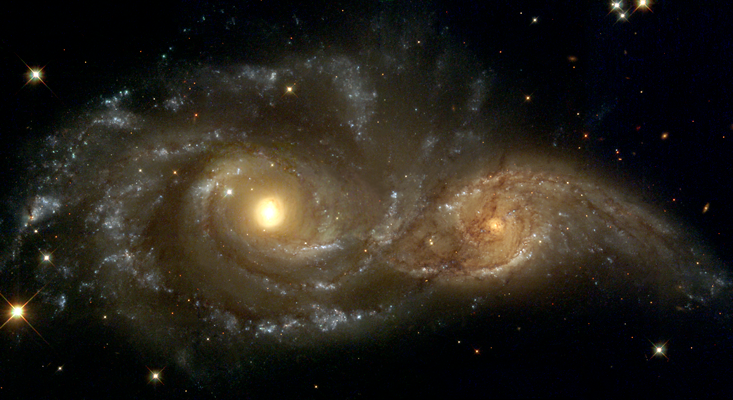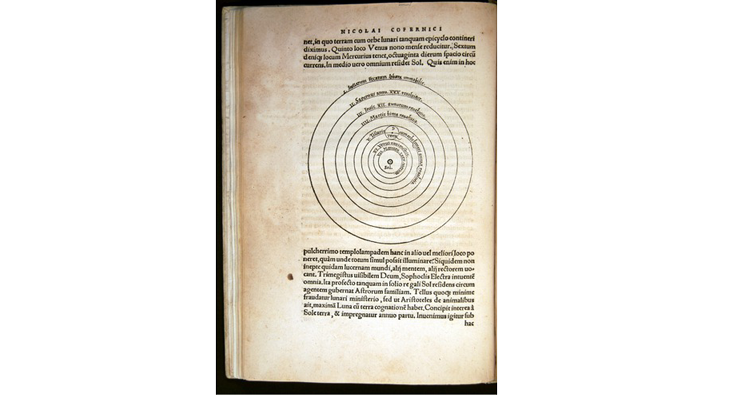The sun formed 4.5 billion years ago, but it’s got around 6 billion years more before its fuel runs out. It will then flare up, engulfing the inner planets. And the expanding universe will continue—perhaps forever—destined to become ever colder, ever emptier. To quote Woody Allen, eternity is very long, especially toward the end.
Any creatures witnessing the sun’s demise won’t be human—they’ll be as different from us as we are from a bug. Posthuman evolution—here on Earth and far beyond—could be as prolonged as the Darwinian evolution that has led to us—and even more wonderful. And evolution will speed up; it can happen via “intelligent design” on a technological timescale, operating far faster than natural selection and driven by advances in genetics and in artificial intelligence (AI). The long-term future probably lies with electronic rather than organic “life.”

In cosmological terms (or indeed in a Darwinian time frame) a millennium is but an instant. So let us “fast forward” not for a few centuries, or even for a few millennia, but for an “astronomical” timescale millions of times longer than that. The “ecology” of stellar births and deaths in our galaxy will proceed gradually more slowly, until jolted by the “environmental shock” of an impact with the Andromeda Galaxy, maybe 4 billion years hence. The debris of our galaxy, Andromeda, and their smaller companions—which now make up what is called the Local Group—will thereafter aggregate into one amorphous swarm of stars.
But on the cosmic scale, gravitational attraction is overwhelmed by a mysterious force latent in empty space that pushes galaxies away from each other. Galaxies accelerate away and disappear over a horizon—rather like an inside-out version of what happens when something falls into a black hole. All that will be left in view, after 100 billion years, will be the dead and dying stars of our Local Group. But these could continue for trillions of years—time enough, perhaps, for the long-term trend for living systems to gain complexity and “negative entropy” to reach a culmination. All the atoms that were once in stars and gas could be transformed into structures as intricate as a living organism or a silicon chip—but on a cosmic scale. Against the darkening background, protons may decay, dark matter particles annihilate, occasional flashes when black holes evaporate—and then silence.
In 1979, Freeman Dyson published a now-classic article whose aim was “to establish numerical bounds within which the universe’s destiny must lie.”1 Even if all material were optimally converted into a computer or superintelligence, would there still be limits on how much information could be processed? Could an unbounded number of thoughts be thought? The answer depends on the cosmology. It takes less energy to carry out computations at low temperatures. For the universe we seem to be in, Dyson’s limit would be finite, but would be maximized if the “thinkers” stayed cool and thought slowly.
If the universe stretches far enough, everything could happen—somewhere far beyond our horizon there could even be a replica of Earth.
Our knowledge of space and time is incomplete. Einstein’s relativity (describing gravity and the cosmos) and the quantum principle (crucial for understanding the atomic scale) are the two pillars of 20th-century physics, but a theory that unifies them is unfinished business. Current ideas suggest that progress will depend on fully understanding what might seem the simplest entity of all—“mere” empty space (the vacuum) is the arena for everything that happens; it may have a rich texture, but on scales a trillion trillion times smaller than an atom. According to string theory, each “point” in ordinary space might, if viewed with this magnification, be revealed as a tightly folded origami in several extra dimensions. There are rival theories, but these invoke the same tiny scale.
The same fundamental laws apply throughout the entire domain we can survey with telescopes. Were that not so—were atoms “anarchic” in their behavior—we’d have made no progress in understanding the observable universe. But this observable domain may not be all of physical reality; some cosmologists speculate that “our” big bang wasn’t the only one—that physical reality is grand enough to encompass an entire “multiverse.”
We can only see a finite volume—a finite number of galaxies. That’s essentially because there’s a horizon, a shell around us, delineating the greatest distance from which light can reach us. But that shell has no more physical significance than the circle that delineates your horizon if you’re in the middle of the ocean. Even conservative astronomers are confident that the volume of spacetime within range of our telescopes—what astronomers have traditionally called “the universe”—is only a tiny fraction of the aftermath of the Big Bang. We’d expect far more galaxies located beyond the horizon, unobservable, each of which (along with any intelligences it hosts) will evolve rather like our own.
It’s a familiar idea that if enough monkeys were given enough time, they would write the works of Shakespeare (and indeed all other books, along with every conceivable string of gobbledygook). This statement is mathematically correct. But the number of “failures” that would precede eventual success is a number with about 10 million digits. Even the number of atoms in the visible universe has only 80 digits. If all the planets in our galaxy were crawling with monkeys, who had been typing ever since the first planets formed, then the best they would have done is typed a single sonnet (their output would include short coherent stretches from all the world’s literatures, but no single complete work). To produce a specific set of letters as long as a book is so immensely improbable that it wouldn’t have happened even once within the observable universe. When we throw dice we eventually get a long succession of sixes, but (unless they are biased) we wouldn’t expect to get more than 100 in a row even if we went on for a billion years.
However, if the universe stretches far enough, everything could happen—somewhere far beyond our horizon there could even be a replica of Earth. This requires space to be VERY big—described by a number not merely with a million digits but with 10 to the power of 100 digits: a one followed by 100 zeroes. Ten to the power of 100 is called a googol, and a number with a googol of zeros is a googolplex.

Given enough space and time, all conceivable chains of events could be played out somewhere, though almost all of these would occur far out of range of any observations we could conceivably make. The combinatorial options could encompass replicas of ourselves, taking all possible choices. Whenever a choice has to be made, one of the replicas will take each option. You may feel that a choice you make is “determined.” But it may be a consolation that, somewhere far away (far beyond the horizon of our observations) you have an avatar who has made the opposite choice.
All this could be encompassed within the aftermath of “our” big bang, which could extend over a stupendous volume. But that’s not all. What we’ve traditionally called “the universe”—the aftermath of “our” big bang—may be just one island, just one patch of space and time, in a perhaps infinite archipelago. There may have been many big bangs, not just one. Each constituent of this “multiverse” could have cooled down differently, maybe ending up governed by different laws. Just as Earth is a very special planet among zillions of others, so—on a far grander scale—our big bang could have been a rather special one. In this hugely expanded cosmic perspective, the laws of Einstein and the quantum could be mere parochial bylaws governing our cosmic patch. So, not only could space and time be intricately “grainy” on a submicroscopic scale, but also, at the other extreme—on scales far larger than astronomers can probe—it may have a structure as intricate as the fauna of a rich ecosystem. Our current concept of physical reality could be as constricted, in relation to the whole, as the perspective of the Earth available to a plankton whose “universe” is a spoonful of water.
Could this be true? A challenge for 21st-century physics is to answer two questions. First, are there many “big bangs” rather than just one? Second—and this is even more interesting—if there are many, are they all governed by the same physics?
If we’re in a multiverse, it would imply a fourth and grandest Copernican revolution; we’ve had the Copernican revolution itself, then the realization that there are billions of planetary systems in our galaxy; then that there are billions of galaxies in our observable universe. But now that’s not all. The entire panorama that astronomers can observe could be a tiny part of the aftermath of “our” big bang, which is itself just one bang among a perhaps infinite ensemble.
Each “point” in ordinary space might be revealed as a tightly folded origami in several extra dimensions.
At first sight, the concept of parallel universes might seem too arcane to have any practical impact. But it may (in one of its variants) actually offer the prospect of an entirely new kind of computer: the quantum computer, which can transcend the limits of even the fastest digital processor by, in effect, sharing the computational burden among a near infinity of parallel universes.
Fifty years ago, we weren’t sure whether there had been a big bang. My Cambridge mentor Fred Hoyle, for instance, contested the concept, favoring a “steady state” cosmos that was eternal and unchanging. (He was never fully converted—in his later years he espoused a compromise idea that might be called a “steady bang.”) Now we have enough evidence, especially from measurements of the primordial background radiation and the relative abundances of hydrogen, helium, and deuterium created in the first three minutes, to delineate cosmic history back to the ultradense first nanosecond—and to do this with as much confidence as a geologist inferring the early history of Earth. So in 50 more years, it is not overoptimistic to hope that we may have a “unified” physical theory, corroborated by experiment and observation in the everyday world, that is broad enough to describe what happened in the first trillionth of a trillionth of a trillionth of a second—where the densities and energies were far higher than the range in which current theories apply. If that future theory were to predict multiple big bangs we should take that prediction seriously, even though it can’t be directly verified (just as we give credence to what Einstein’s theory tells us about the unobservable insides of black holes, because the theory has survived many tests in domains we can observe).
So we may, by the end of this century, be able to ask whether or not we live in a multiverse, and how much variety its constituent “universes” display. The answer to this question will determine how we should interpret the “biofriendly” universe in which we live (sharing it with any aliens with whom we might one day make contact).
My 1997 book, Before the Beginning speculated about a multiverse.2 Its arguments were partly motivated by the seemingly “biophilic” and fine-tuned character of our universe. This would occasion no surprise if physical reality embraced a whole ensemble of universes that “ring the changes” on the basic constants and laws. Most would be stillborn or sterile, but we would find ourselves in one of those where the laws permitted emergent complexity. This idea had been bolstered by the “cosmic inflation” theory of the 1980s, which offered new insights into how our entire observable universe could have “sprouted” from an event of microscopic size. It gained further serious attention when string theorists began to favor the possibility of many different vacuums—each an arena for microphysics governed by different laws.
I’ve ever since had a close-up view of this shift in opinion and the emergence of these (admittedly speculative) ideas. In 2001, I helped organize a conference on this theme. It took place in Cambridge, but not in the university. I hosted it at my home, a farmhouse on the edge of the city, in a converted barn that offered a somewhat austere location for our discussions. Some years later, we had a follow-up conference. This time the location was very different: a rather grand room in Trinity College, with a portrait of Newton (the college’s most famous alumnus) behind the podium.
The theorist Frank Wilczek (famous for his role, while still a student, in formulating what is called the “standard model” of particle physics) attended both meetings. When he spoke at the second, he contrasted the atmosphere at the two gatherings. He described physicists at the first meeting as ‘fringe’ voices in the wilderness who had for many years promoted strange arguments about conspiracies among fundamental constants and alternative universes. Their concerns and approaches seemed totally alien to the consensus vanguard of theoretical physics, which was busy successfully constructing a unique and mathematically perfect universe. But at the second meeting, he noted that “the vanguard had marched off to join the prophets in the wilderness.”
Some years later, I was on a panel at Stanford University where we were asked by the chairman, the astronomer Bob Kirshner: “On the scale, ‘would you bet your goldfish, your dog, or your life,’ how confident are you about the multiverse concept?” I said that I was nearly at the dog level. Andrei Linde, a Russian cosmologist who had spent 25 years promoting a theory of “eternal inflation” said he’d almost bet his life. Later, on being told this, the eminent theorist Steven Weinberg said he’d happily bet Martin Rees’s dog and Andrei Linde’s life.
Andrei Linde, my dog, and I will all be dead before this is settled. It’s not metaphysics. It’s highly speculative. But it’s exciting science. And it may be true.
Martin Rees is a British cosmologist and astrophysicist. He is also the Astronomer Royal.
Excerpted from On The Future: Prospects for Humanity by Martin Rees. Copyright © 2018 by Princeton University Press. Reprinted by permission.
References
1. Dyson, F. Time without end: Physics and biology in an open universe. Reviews of Modern Physics 51 447–460 (1979).
2. Rees, M. Before the Beginning: Our Universe and Others Basic Books, New York, NY (1997).
Lead image credit: SpeedRunnerOfPersia / Wikimedia


























